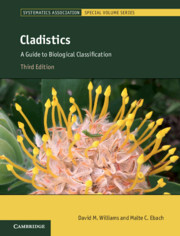Book contents
- Cladistics
- The Systematics Association Special Volume Series
- Cladistics
- Copyright page
- Dedication
- Contents
- Preface
- Acknowledgements
- Introduction: Carving Nature at Its Joints, or Why Birds Are Not Dinosaurs and Men Are Not Apes
- Part I The Interrelationships of Organisms
- Part II Systematics: Exposing Myths
- Part III The Cladistic Programme
- Part IV How to Study Classification
- 8 Modern Artificial Methods and Raw Data
- 9 How to Study Classification: Consensus Techniques and General Classifications
- 10 How to Study Classification: ‘Total Evidence’ vs. ‘Consensus’, Character Congruence vs. Taxonomic Congruence, Simultaneous Analysis vs. Partitioned Data
- 11 How to Study Classification
- 12 How to Study Classification
- Part V Beyond Classification
- Afterword
- Index
- Systematics Association Special Volumes
- References
12 - How to Study Classification
Natural Methods II: Beyond Method, the Philosophy of Three-Item Analysis
from Part IV - How to Study Classification
Published online by Cambridge University Press: 20 July 2020
- Cladistics
- The Systematics Association Special Volume Series
- Cladistics
- Copyright page
- Dedication
- Contents
- Preface
- Acknowledgements
- Introduction: Carving Nature at Its Joints, or Why Birds Are Not Dinosaurs and Men Are Not Apes
- Part I The Interrelationships of Organisms
- Part II Systematics: Exposing Myths
- Part III The Cladistic Programme
- Part IV How to Study Classification
- 8 Modern Artificial Methods and Raw Data
- 9 How to Study Classification: Consensus Techniques and General Classifications
- 10 How to Study Classification: ‘Total Evidence’ vs. ‘Consensus’, Character Congruence vs. Taxonomic Congruence, Simultaneous Analysis vs. Partitioned Data
- 11 How to Study Classification
- 12 How to Study Classification
- Part V Beyond Classification
- Afterword
- Index
- Systematics Association Special Volumes
- References
Summary
From the preceding chapters – and the wealth of literature on the subject – one thing seems clear: different solutions to systematic problems are possible from different methods, whether those methods are directed toward the analysis of raw data or the analysis of cladograms (consensus). Once again the issue is whether the solutions found (by whatever means, data or method, or combination thereof) represent aspects of the natural world or include artefacts of the methods used.
- Type
- Chapter
- Information
- CladisticsA Guide to Biological Classification, pp. 287 - 350Publisher: Cambridge University PressPrint publication year: 2020

